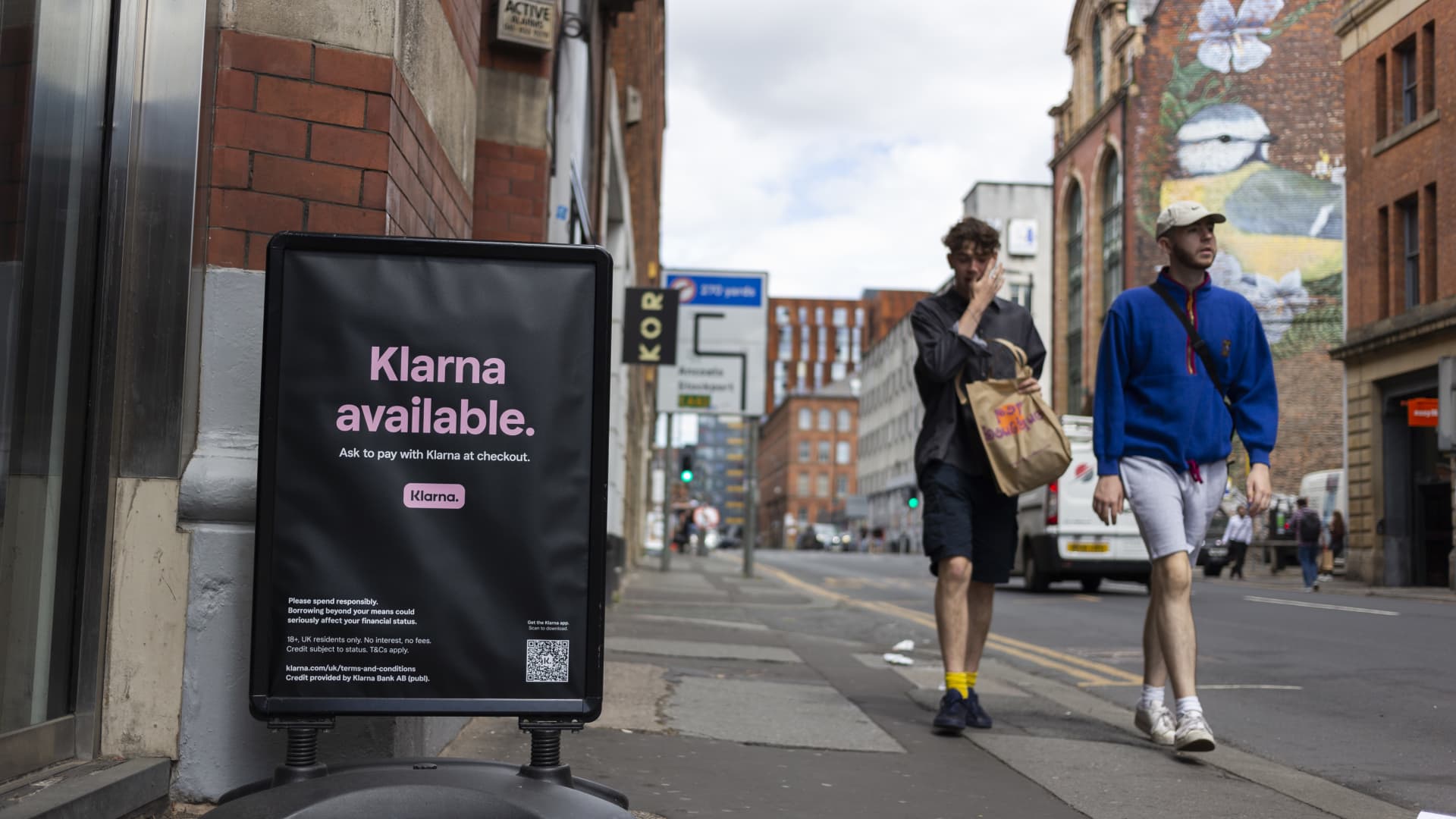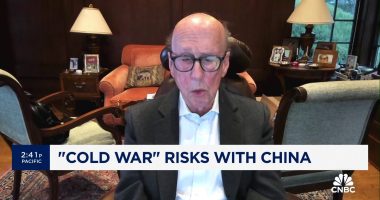
Pedestrians walk by an advertisement for Klarna.
Daniel Harvey Gonzalez | In Pictures via Getty Images
When she started shopping for the holidays late last year, Kiki Andersen was struggling to buy her loved ones gifts. So she turned to a novel solution to get through the season: Buy now, pay later.
The 31-year-old comedian from Los Angeles used Klarna and PayPal to split a variety of purchases into four interest-free payments spread out over a series of weeks. At the time, her upfront cost was about a quarter of the overall purchase price.
But now that January has arrived and the other installments are starting, Andersen isn’t sure how she’s going to pay them off. She has found herself buried under a mountain of micro payments, wondering how she’s going to cover her bills.
“I’ve definitely been selling clothes … if I have to go sell a pair of shoes to make a payment, I will,” Andersen told CNBC of the roughly $1,700 she racked up in buy now, pay later debt. “I’m definitely worried about [the payments]. It’s definitely a concern and I’m definitely going to have to find a way to come up with the money.”
Andersen is one of many Americans who turned to buy now, pay later to fund their holiday shopping last year to avoid credit card debt but are now having trouble paying off those bills.
In an era where persistent inflation and record-high interest rates are shaping financial decisions for many shoppers, the service helped fuel a boom in overall online spending that topped out at $222 billion from Nov. 1 through the end of December. During the season, buy now, pay later usage hit an all-time high, rising a staggering 14% from the prior year and contributing $16.6 billion to online spending.
On Cyber Monday alone, buy now, pay later use spiked nearly 43%, Adobe said.
“Sales, especially online sales, were probably juiced to some extent because of buy now, pay later usage,” said Ted Rossman, senior analyst at Bankrate. “A lot of people are drawn to this financing method as an alternative to something like a credit card where the average interest rate is a record high 20.74%. I would caution that you can still get into trouble with buy now, pay later … it can still encourage you to overspend and kind of trick yourself.”
The surge in use of buy now, pay later comes as credit card debt hits a record high and delinquency rates have nearly doubled over the past two years. While delinquencies were at historic lows during the Covid-19 pandemic, the rate of people who’ve gone more than 30 days without paying their credit card bill recently topped pre-pandemic levels, according to the Federal Reserve.
It’s tough to say how buy now, pay later fits into the country’s overall debt picture. Providers that offer the service don’t typically disclose how often those bills go unpaid, and the debts aren’t reported to credit bureaus. Klarna, PayPal and Affirm all declined to share buy now, pay later delinquency rates with CNBC.
Affirm has said the short-term and high-velocity nature of its buy now, pay later service makes traditional credit metrics less relevant. It writes off those unpaid loans within 120 days, which is why it doesn’t disclose delinquency rates for the service. It does disclose other credit metrics for its longer-term loans.
Klarna and Affirm previously told CNBC their underwriting strategies ensure that only people who can pay back the short-term loans can access the service because their business models wouldn’t work if people frequently missed payments. While Klarna charges late fees that top out at 25% of the purchase price, according to a review of its terms and conditions, Affirm does not.
Klarna said its global default rate for its overall business including buy now, pay later is less than 1%. In the U.S., 35% of consumers pay the company back early, it said.
The opacity surrounding the novel service has created a so-called phantom debt phenomenon that has left economists, regulators and even shoppers concerned about the effect it could have on the economy.
“It’s just this nebulous cloud of debt. Nobody really knows how it works and it’s just floating around us all the time and it definitely feels like a pending housing crisis, almost like 2008 but for shopping,” Andersen joked. “That’s the myth that Klarna and PayPal sell you on, is that you can have this lifestyle, you can have these things, but the truth is, you can’t.”
The ‘beast’ of buy now, pay later
Alaina Fingal, a New Orleans-based financial coach and the founder of The Organized Money, typically receives five or six emails at the beginning of January from people who overspent during the holidays and need help managing their finances.
This year, it was closer to 20 or 25.
“Most people used all of their cash, they ran out of cash, then they would put it on a credit card and then if they maxed out credit cards, then they would go to other services like buy now, pay later,” Fingal told CNBC.
Fingal said she spoke with one client who had two maxed-out credit cards and used two buy now, pay later services, leaving her struggling to make payments.
“Since she couldn’t afford it in the first place, those minimum payments are causing her to struggle a lot to cover food and her regular bills for this month,” said Fingal. “So it just creates this cycle that becomes harder and harder to come out of.”
While it’s unclear how often buy now, pay later bills go unpaid, the people who use them are more than twice as likely to be delinquent on another credit product, such as a car loan, personal loan or mortgage, according to a 2023 study from the Consumer Financial Protection Bureau. People who use the service also tend to have higher balances on other credit products and lower credit scores, according to the CFPB.
As more shoppers use the products, consumers are torn about how they feel about it. In the weeks after Christmas, some on the social media platform X, formerly known as Twitter, said they were grateful for buy now, pay later and wouldn’t have been able to buy holiday gifts without it.
Others called it “dangerous” and vowed to stop using it as a New Year’s resolution. At least one shopper said they had to use their rent money to pay their buy now, pay later bill.
“Buy now, pay later is a beast. It definitely is. But you have to be the bigger beast,” said Hensley Resiere, a loyal Klarna user, in response to the difficulties some shoppers have with the service.
In an interview with CNBC, the 34-year-old refugee caseworker from Jersey City, New Jersey, said Klarna helped her provide an “amazing” Christmas for her family. But when she first started using buy now, pay later during the Covid-19 pandemic, she had trouble keeping track of the payments and found herself overdrafted by hundreds of dollars and crushed with fees.
“When I realized I can still get what I want, like designer items, and not have to pay the full purchase on spot, I lost my damn mind. … It was like a kid in a candy store,” Resiere recalled. “Let’s say Klarna gave me $1,000. In my head, I was like, ‘Oh my God, that’s free money.’ So I’m spending the whole thousand, forgetting that I have rent, car note, car insurance, all these bills, groceries, everything.”
Resiere was in a cycle where she had to wait to get paid to cover her overdraft fees. These days, she has a system in place to manage the payments so they don’t interfere with her other bills.
“Even though I’m in my career now and of course making more money, any way that I can split my payments and not worry about bills, I’m definitely, definitely all for,” said Resiere. “It splits the payments so I don’t really feel it. Yes, I’m paying the same amount but the fact that it’s being spread out, it doesn’t hurt as much.”
Branika Pride, a mom of three who lives in Birmingham, Alabama, and works in higher education, told CNBC she used Afterpay, Block‘s buy now, pay later service, this Christmas to buy her kids an icemaker, a PlayStation 5 and Drake concert tickets. She uses a variety of providers, depending on what the retailer offers. Pride said the service came in handy this Christmas because she waited until the last minute to start shopping and was reluctant to put down the full cost of the purchases at once.
“I’ve used it in the past, not as heavy as I did this time,” she said, adding that she racked up about $1,300 in buy now, pay later debt over the holidays. “I just really didn’t get into the holiday spirit until the week of Christmas. So it was just kind of funny at the end when I was just making all the purchases I was like, ‘Ooh, I’m gonna regret this in two weeks.'”
Pride said she’s never had trouble covering her buy now, pay later payments and typically uses the service around payday, so she knows she’ll have the funds by the time the next installment rolls around. She appreciates the flexibility that it offers her, but acknowledged that it can promote overspending or get in the way of her larger financial goals. Without it, she probably wouldn’t buy as many discretionary items as she does.
“Every year I say I don’t want to take it into the New Year,” said Pride. “But somehow, it always comes with me.”
Don’t miss these stories from CNBC PRO:
Read More: World News | Entertainment News | Celeb News
CNBC










